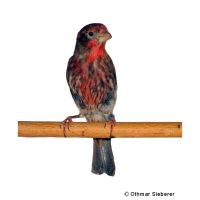House Finch (Haemorhous mexicanus)
| House Finch Haemorhous mexicanus | |
|---|---|
| Name | House Finch |
| Name Lat. | Haemorhous mexicanus |
| Synonym | Carpodacus mexicanus |
| Family | Finches and Allies |
| Family lat. | Fringillidae |
| Order | Perching Birds |
| Order lat. | Passeriformes |
| Origin | North America |
| Climate | Temperate - subtropical |
| Diet | Woodland Bird seed, veggies, fruits |
| Keeping | Pair, group |
| Care Level | Easy |
| Reproduction | Cup nest |
| Life Span | 5-10 years |
| Protection | No |
| Metric Units | |
| Size | 15 cm |
| Temperature | Room temperature |
| Housing | 120 x 50 x 80 cm |
| US Units | |
| Size | 5.9" |
| Temperature | Room temperature |
| Housing | 45" x 20" x 30" |
Distribution and habitat
The home of the wild form are forest edges, park-like landscapes and cultivated land up to 1500 m altitude from the western USA to Lower California and Guerrero in Mexico. Today they are only available as cultivated form in many color mutations.
Cage size
The minimum cage size is 120 x 50 x 80 cm (L x W x H) for a pair. The cage size must not be undercut even in case of justified single keeping. For an additional 2 birds, assuming species compatibility, the floor space must be increased by 25%. The cage must be placed in a bright, draught-free and quiet place at a height of at least 80 cm (except aviaries), have a rectangular base and be opaque on three sides, aviaries on one side. An aviary is required for flocking.
Maintenance
The ground must be covered with sand, leaves, wood granulate, bark mulch or similar material and must be cleaned regularly. They need perching, hiding, roosting and nesting opportunities, as well as biotope-like furnishings with grasses, shrubbery and natural planting. At least 3 perches made of wood or branches of varying thickness and height must be installed in such a way that they can only be reached by flying and that the longest possible flight distance is created. A bathing facility must be provided at all times. They should be kept at room temperature.
Diet
The species-specific feed consists of mixed seeds, available in specialized trade as "forest bird mixed feed" in premium quality, in addition green millet, chickweed, dandelion, berries, buds, fruit and especially when raising young, germinated seeds, untreated lettuce, egg feed, insects and insect larvae (ant pupae, small buffalos, pinkies, aphids). Charcoal, vitamine lime, cuttlefish and shell grit are needed as digestive aids. Drinking water must always be available in birdbaths or in stable, open containers and, like food, must be offered fresh daily in clean containers.
A varied diet promotes health and prevents deficiency symptoms.
Reproduction and breeding
The sexes are clearly distinguishable. In males, the front head and chest are intensely colored red, females are gray-brown.
They like to breed in open nap-shaped nest pads made of wicker covered with brushwood or also freely in dense bushes. Suitable nesting materials include sisal, jute and coconut fibers, sharpie, and animal hair. The clutch consists of 3-5 eggs, the incubation period is about 13 days. The incubation period is, biologically speaking, from March to August when kept in outdoor aviaries. The room temperature for breeding should be at least 15 °C.
Important
The birds may only be kept in pairs or groups. The Haemorhous mexicanus is also known as Carpodacus mexicanus.
If kept indoors, an indoor aviary with a floor area of at least 0.6 m² and 1.5 m in height is recommended. For outdoor aviary keeping, they also need a heated shelter of at least 1 m² floor area, which can be visited by the birds at any time. The temperature in the shelter must not fall below 5 °C and the furnishings must be the same as those used for caging. Round aviaries with a diameter of less than 2 m are not allowed.
Sufficient daylight or flicker-free artificial light (stroboscopic effect) corresponding to the light spectrum of natural sunlight must be provided in rooms, including shelters. The lighting duration must be between 8 and 14 hours per day. The day-night rhythm must be observed. An adequate indoor climate must be provided. The health condition of the birds must be checked daily
Further literature can be found in your pet store.
References
Text: Othmar Sieberer; Image: Othmar Sieberer
Source: BMELV (1995): Tierschutzgutachten - Mindestanforderungen an die Haltung von Kleinvögeln; CLASSEN & MASSOTH (1992): Handbuch der Cardueliden, Band 2, Hanke Verlag
- Gemäß § 21 Abs. 5 Tierschutzgesetz idgF
